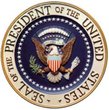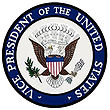Chester A. Arthur
From Wikipedia, the free encyclopedia.
| Term of office | September 19, 1881 – March 3, 1885 |
| Preceded by | James A. Garfield |
| Succeeded by | Grover Cleveland |
| Date of birth | October 5, 1829 |
| Place of birth | Fairfield, Vermont |
| Spouse | Ellen Lewis Herndon Arthur |
| Political party | Republican |
Chester Alan Arthur (October 5, 1829 – November 18, 1886) was an American politician who served as 21st President of the United States. Arthur was a member of the Republican Party and worked as a lawyer before becoming the 20th Vice President in the administration of James Garfield. Garfield was shot by Charles Guiteau, a disgruntled office seeker, on July 2, 1881. Garfield died on September 19, and Arthur became President, serving until 1885.
Before entering national politics, Arthur had been Collector of Customs for the Port of New York. He was appointed by President Ulysses Grant but was fired by Grant's successor, Rutherford Hayes, under (false) suspicion of bribery and corruption because he was part of the Tammany Hall political machine. His notable achievements in office as President included civil service reform and the passage of the Pendleton Act. Arthur is also remembered as one of the most society-conscious presidents, earning the nickname "the Gentleman Boss" for his style of dress and courtly manner, and was widely popular by the time he left office; in fact, not one but four young women (ignorant of Arthur's pronouncement that he would never marry again) proposed to him on the day he left office. He was also sometimes called "Elegant Arthur" for his commitment to fashionable attire. He was said to have "looked like a president". He kept 80 pairs of pants in his wardrobe, and changed pants several times a day. He was called "Chet" by family and friends. Interestingly, Arthur pronounced his middle name, Alan, with the stress on the second syllable -- "Al-AN."
Arthur suffered from Bright's Disease and died of a cerebral hemorrhage, most likely related to a history of hypertension, approximately twenty-four hours after being found unconscious by his nurse.
Contents |
Biography
Arthur was born in the town of Fairfield in Franklin County, Vermont on October 5, 1829 (although he told people that he was born in 1830). Political rivals long circulated the rumor that he had been born in Canada rather than in Vermont, hoping to create doubts as to his eligibility for American public office. The truth, however, was simply that Arthur was born near the Canadian border. His parents were William Arthur and Malvina Stone.
He attended the public schools and was graduated from Union College, Schenectady, New York, in 1848. He became principal of an academy in North Pownal, Vermont in 1851. He studied law, was admitted to the bar in 1854, and commenced practice in New York City, supporting equal rights for blacks who objected to the segregation of city transportation. He also took an active part in the reorganization of the New York State militia.
Arthur married Ellen "Nell" Lewis Herndon on October 25, 1859. In 1860, the couple had a son, William Lewis Herndon Arthur, who was named after Mrs. Arthur's father. William Lewis died at age two of a brain disorder. Another boy, Chester Alan Arthur II, was born in 1864, and a girl, named Ellen Herndon for her mother, in 1871. Ellen Lewis Herndon Arthur died of pneumonia on January 12, 1880, at the age of 42, 10 months before Arthur was elected Vice President. While in the White House, Arthur would not give anyone the place that would have been his wife's. He asked his sister Mary (Mrs. John E. McElroy) to assume certain social duties and help care for his daughter.
During the Civil War, Arthur served as acting quartermaster general of the state in 1861 and was widely praised for his service. He was later commissioned as inspector general, and appointed quartermaster general with the rank of Brigadier General, and served until 1862. He resumed the practice of law in New York City. With the help of Arthur's patron and political boss Roscoe Conkling, Arthur was appointed by President Ulysses Grant as Collector of the port of New York from 1871 to 1878.
This was an extremely lucrative and powerful position at the time, and several of Arthur's predecessors had run afoul of the law while serving as Collector. Honorable in his personal life and his public career, Arthur nevertheless was a firm believer in the spoils system even as it was coming under vehement attack from reformers. He insisted upon honest administration of the Customs House, but staffed it with more employees than it really needed, retaining some for their loyalty as party workers rather than for their skill as public servants.
In 1878 President Rutherford Hayes, attempting to reform the Customs House, ousted Arthur, who resumed the practice of law in New York City. Conkling and his followers tried to win redress by fighting for the renomination of Grant at the 1880 Republican Convention. Failing in that, they reluctantly accepted the nomination of Arthur for the Vice Presidency.
Arthur was elected Vice President of the United States on the Republican ticket with President James Garfield for the term beginning March 4, 1881. Upon the assassination of President Garfield, Arthur became President of the United States on September 19, 1881 and was sworn in September 20th
Presidency
Avoiding old political cronies, Arthur determined to go his own way once in the White House. He became a man of fashion in his garb and associates, and often was seen with the elite of Washington, D.C., New York, and Newport. To the indignation of the Stalwart Republicans, the onetime Collector of the Port of New York became, as President, a champion of civil service reform. Public pressure, heightened by the assassination of Garfield, forced an unwieldy Congress to heed the President.
In 1883 Congress passed the Pendleton Act, which established a bipartisan Civil Service Commission, forbade levying political assessments against officeholders, and provided for a "classified system" that made certain Government positions obtainable only through competitive written examinations. The system protected employees against removal for political reasons.
Acting independently of party dogma, Arthur also tried to lower tariff rates so the Government would not be embarrassed by annual surpluses of revenue. Congress raised about as many rates as it trimmed, but Arthur signed the Tariff Act of 1883 anyway. Aggrieved Westerners and Southerners looked to the Democratic Party for redress, and the tariff began to emerge as a major political issue between the two parties.
The Arthur Administration enacted the first general Federal immigration law. Arthur approved a measure in 1882 excluding paupers, criminals, and the mentally ill. Congress also suspended Chinese immigration for ten years, later making the restriction permanent.
In 1884 the International Meridian Conference was held in Washington at President Arthur´s behest. This established the Greenwich Meridian which is still in use today.
President Arthur demonstrated that he was above factions within the Republican Party, if indeed not above the party itself. Perhaps in part his reason was the well-kept secret he had known since a year after he succeeded to the Presidency, that he was suffering from Bright's Disease, a fatal kidney disease (see 'Presidential disability prior to 1967' in Acting President of the United States).
Arthur kept himself in the running for the Presidential nomination in 1884 in order not to appear that he feared defeat, but was not renominated.
Publisher Alexander K. McClure wrote, "No man ever entered the Presidency so profoundly and widely distrusted, and no one ever retired ... more generally respected." Author Mark Twain, deeply cynical of politicians, conceded, "It would be hard indeed to better President Arthur's administration."
Cabinet
| OFFICE | NAME | TERM |
| President | Chester A. Arthur | 1881–1885 |
| Vice President | None | 1881–1885 |
| Secretary of State | F. T. Frelinghuysen | 1881–1885 |
| Secretary of the Treasury | Charles J. Folger | 1881–1884 |
| Walter Q. Gresham | 1884 | |
| Hugh McCulloch | 1884–1885 | |
| Secretary of War | Robert T. Lincoln | 1881–1885 |
| Attorney General | Benjamin H. Brewster | 1881–1885 |
| Postmaster General | Timothy O. Howe | 1881–1883 |
| Walter Q. Gresham | 1883–1884 | |
| Frank Hatton | 1884–1885 | |
| Secretary of the Navy | William H. Hunt | 1881–1882 |
| William E. Chandler | 1882–1885 | |
| Secretary of the Interior | Samuel J. Kirkwood | 1881–1882 |
| Henry M. Teller | 1882–1885 | |
Significant events during presidency
- Standard Oil founded (1882)
- Chinese Exclusion Act (1882)
- Pendleton Civil Service Reform Act (1883)
- Civil Rights Cases (1883)
Post presidency
Arthur served as president through March 3, 1885. Upon leaving office, he returned to New York City where he died of a massive cerebral hemorrhage at 5:10 a.m. on Thursday November 18, 1886, at the age of 57. His time as a former president was the second shortest, longer only of that of James Polk.
Chester was buried next to Ellen in the Arthur family plot in the Albany Rural Cemetery in Albany, New York, in a large sarcophagus on a large corner plot that contains the graves of many of his family members and ancestors.
External links
- First State of the Union Address of Chester A. Arthur
- Second State of the Union Address of Chester A. Arthur
- Third State of the Union Address of Chester A. Arthur
- Fourth State of the Union Address of Chester A. Arthur
- White House Biography
- Works by Chester Alan Arthur at Project Gutenberg
| Preceded by: William A. Wheeler |
Republican Party Vice Presidential candidate 1880 (won) |
Succeeded by: John A. Logan |
| Preceded by: William A. Wheeler |
Vice President of the United States March 4, 1881 – September 19, 1881(a) |
Succeeded by: Thomas A. Hendricks |
| Preceded by: James A. Garfield |
President of the United States September 19, 1881(b) – March 3, 1885 |
Succeeded by: Grover Cleveland |
| Presidents of the United States of America |  |
|---|---|
| Washington | J Adams | Jefferson | Madison | Monroe | JQ Adams | Jackson | Van Buren | W Harrison | Tyler | Polk | Taylor | Fillmore | Pierce | Buchanan | Lincoln | A Johnson | Grant | Hayes | Garfield | Arthur | Cleveland | B Harrison | Cleveland | McKinley | T Roosevelt | Taft | Wilson | Harding | Coolidge | Hoover | F Roosevelt | Truman | Eisenhower | Kennedy | L Johnson | Nixon | Ford | Carter | Reagan | GHW Bush | Clinton | GW Bush |
| Vice Presidents of the United States of America |  |
|---|---|
| Adams | Jefferson | Burr | Clinton | Gerry | Tompkins | Calhoun | Van Buren | R Johnson | Tyler | Dallas | Fillmore | King | Breckinridge | Hamlin | A Johnson | Colfax | Wilson | Wheeler | Arthur | Hendricks | Morton | Stevenson | Hobart | Roosevelt | Fairbanks | Sherman | Marshall | Coolidge | Dawes | Curtis | Garner | Wallace | Truman | Barkley | Nixon | L Johnson | Humphrey | Agnew | Ford | Rockefeller | Mondale | Bush | Quayle | Gore | Cheney |
| United States Republican Party Vice Presidential Nominees |  |
|---|---|
| Dayton | Hamlin | Colfax | Wilson | Wheeler | Arthur | Logan | Morton | Reid | Hobart | Roosevelt | Fairbanks | Sherman | Butler | Fairbanks | Coolidge | Dawes | Curtis | Knox | McNary | Bricker | Warren | Nixon | Lodge | Miller | Agnew | Dole | Bush | Quayle | Kemp | Cheney |




